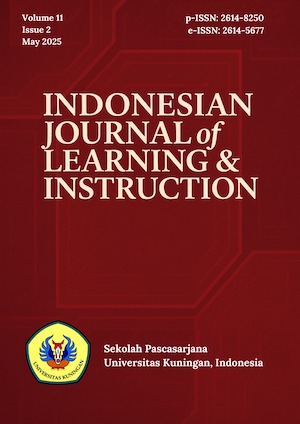STUDENTS PERSPECTIVE ON ASYNCHRONOUS AND SYNCHRONOUS TYPE OF E- LEARNING AT BAN OOM SCHOOL THAILAND
Abstract
During Covid-19 pandemic, the main focus of education is distance learning. Especially for learning strategy. In this research, the researcher used two strategies; synchronous focuses on e-learning using Zoom and asynchronous using video material. Researchers used two of strategies to measure which strategy is more effective to assist students in facilitating e-learning process. The process also aimed to reach students and teach them from home during quarantine. This paper examined students' perceptions of e-learning using synchronous (zoom) and asynchronous (video material) at Ban Oom school of Thailand. The students have experience of implementing the strategies 4 (four) months during e-learning. There are 25 students participated on the learning process. The study used quantitative and qualitative design with triangulation approaches, with the analysis instrument being a questionnaire with Likert scale questions. According to the findings of the observations, there are three activity factors (communication, learning materials and the learning process). The analysis instrument is a questionnaire consisting of Likert scale questions. The findings from the questionnaire showed positive answers to all the three factors. The students agreed that they can communicate easily. It shows that students have a high perspective on synchronous learning with various advantages compared to asynchronous learning where learning by watching videos that sent by the teacher and cannot interact directly if there are something is not understood by the students.
Keywords: students’ perspective; asynchronous and keyword synchronous; e-learning.
References
Altıner, C. (2015). Perceptions of undergraduate students about synchronous video conference-based English courses. Procedia - Social and Behavioral Sciences, 199(4452), 627–633. https://doi.org/10.1016/j.sbspro.2015.07.589
Choe, R. C., Scuric, Z., Eshkol, E., Cruser, S., Arndt, A., Cox, R., Toma, S. P., Shapiro, C., Levis-Fitzgerald, M., Barnes, G., & Crosbie, R. H. (2019). Student satisfaction and learning outcomes in asynchronous online lecture videos. CBE Life Sciences Education, 18(4). https://doi.org/10.1187/cbe.18-08-0171
Conklina, S., Oyarzun, B., & Barreto, D. (2017). Blended synchronous learning environment: Student perspectives. Research on Education and Media, 9(1), 17–23. https://doi.org/10.1515/rem-2017-0004
Kantar, M., İbili, E., Bayram, F., Hakkari, F., & Doğan, M. (2008). Software and content creation on distance education systems. Conference Proceeding. Istanbul University Press, 4793, 334-343.
Narayan, A. D. (1976). Inheritance of Body Eight and Rate of Gain in Japanese Quail. British Poultry Science, 17(5), 513–523.
National Center for Immunization and Respiratory Diseases (NCIRD). (2021). Implementation of Mitigation Strategies for Communities with Local COVID-19 Transmission. Cdc, 1. https://www.cdc.gov/coronavirus/2019-ncov/community/community-mitigation.html
Ngampornchai, A., & Adams, J. (2016). Students’ acceptance and readiness for E-learning in Northeastern Thailand. International Journal of Educational Technology in Higher Education, 13(1). https://doi.org/10.1186/s41239-016-0034-x
Öz, R., & Kayalar, M. T. (2021). A Comparative Analysis on the Effects of Formal and Distance Education Students’ Course Attendance Upon Exam Success. Journal of Education and Learning, 10(3), 122. https://doi.org/10.5539/jel.v10n3p122
Panyajamorn, T., Suanmali, S., Kohda, Y., Chongphaisal, P., & Supnithi, T. (2018). Effectiveness of E-Learning Design in Thai Public Schools. Malaysian Journal of Learning and Instruction, 15(1), 1–34.
Shamsudin, H., Hashim, H., & Yunus, M. M. (2019). Integration of Asynchronous and Synchronous Gameplay to Improve Pupils’ Vocabulary. Creative Education, 10(12), 3101–3106. https://doi.org/10.4236/ce.2019.1012234
Wang, Q., Huang, C., & Quek, C. L. (2018). Students’ perspectives on the design and implementation of a blended synchronous learning environment. Australasian Journal of Educational Technology, 34(1), 1–13. https://doi.org/10.14742/ajet.3404
Wang, R. L., & Wiesemes, R. (2012). Enabling and supporting remote classroom teaching observation: Live video conferencing uses in initial teacher education. Technology, Pedagogy and Education, 21(3), 351–360. https://doi.org/10.1080/1475939X.2012.719397
Warden, C. A., Stanworth, J. O., Ren, J. B., & Warden, A. R. (2013). Synchronous learning best practices: An action research study. Computers and Education, 63, 197–207. White, C. P., Ramirez, R., Smith, J. G., & Plonowski, L. (2010). Simultaneous delivery of a face-to-face course to on-campus and remote off-campus students. TechTrends, 54(4), 34–40. https://doi.org/10.1007/s11528-010-0418-z
Wright, B. M. (2017). Blended learnings student perception of face-to-face and online EFL lessons. Indonesian Journal of Applied Linguistics, 7(1), 64–71. https://doi.org/10.17509/ijal.v7i1.6859









